Onam is the biggest and the most important festival of the state of Kerala. It is a harvest festival and is celebrated with joy and enthusiasm all over the state by people of all communities. According to a popular legend, the festival is celebrated to welcome King Mahabali, whose spirit is said to visit Kerala at the time of Onam.
Onam is celebrated in the beginning of the month of Chingam, the first month of Malayalam Calendar (Kollavarsham). This corresponds with the month of August-September according to Gregorian Calendar.
Carnival of Onam lasts from four to ten days. First day, Atham and tenth day, Thiruonam are most important of all. Popularity and presentation of rich culture of the state during the carnival made Onam the National Festival of Kerala in 1961. Elaborate feasts, folk songs, elegant dances, energetic games, elephants, boats and flowers all are a part of the dynamic festival called Onam.
Government of India has taken due notice of this vibrant and colorful festival. It promotes Onam internationally in a big way and celebrates 'Tourist Week' for Kerala during Onam celebrations. Thousands of domestic and foreign tourists visit Kerala to be a part of Onam.
Story goes that during the reign of mighty king, Mahabali, Kerala witnessed its golden era. Everybody in the state was happy and prosperous and king was highly regarded by his subjects. Apart from all his virtues, Mahabali had one shortcoming. He was egoistic. This weakness in Mahabali's character was utilized by Gods to bring an end to his reign as they felt challenged by Mahabali's growing popularity. However, for all the good deed done by Mahabali, God granted him a boon that he could annually visit his people with whom he was so attached.
It is this visit of Mahabali that is celebrated as Onam every year. People make all efforts to celebrate the festival in a grand way and impress upon their dear King that they are happy and wish him well.
Rich cultural heritage of Kerala comes out in its best form and spirit during the ten day long festival. It is indeed a treat to be a part of the grand carnival. People of Kerala make elaborate preparations to celebrate it in the best possible manner.
The most impressive part of Onam celebration is the grand feast called Onasadya, prepared on Thiruonam. It is a nine course meal consisting of 11 to 13 essential dishes. Onasadya is served on banana leaves and people sit on a mat laid on the floor to have the meal.
Another enchanting feature of Onam is Vallamkali, the Snake Boat Race, held on the river Pampa. It is a colourful sight to watch the decorated boat oared by hundreds of boatmen amidst chanting of songs and cheering by spectators.
There is also a tradition to play games, collectively called Onakalikal, on Onam. Men go in for rigorous sports like Talappanthukali (played with ball), Ambeyyal (Archery), Kutukutu and combats called Kayyankali and Attakalam. Women indulge in cultural activities. They make intricately designed flower mats called, Pookalam in the front courtyard of house to welcome King Mahabali. Kaikotti kali and Thumbi Thullal are two graceful dances performed by women on Onam. Folk performances like Kummatti kali and Pulikali add to the zest of celebrations.
Onam is the biggest festival of Kerala. But, there is a lot more to Onam than being just a festival. Onam reflects the faith of the people of Kerala; A belief in their legendary past, religion and power of worship. It shows the high spirit of the people who go out of the way to celebrate the festival in the prescribed manner and a grand fashion.
Best of Season and Weather
Onam is also a harvest festival. It is celebrated at a time when everything appears so nice and good. The beautiful landscape of Kerala can be seen in its full radiance at this time of the Malayalam New Year. Weather, it seems, also seeks to be a part of the festival. It contributes by becoming pleasantly warm and sunny. Fields look brilliant with a bountiful harvest. Farmers feel on top of the world as they watch the result of their hard labour with pride.
Children's Joy and Homecoming
Children eagerly wait for the arrival of the carnival. Why shouldn't they. It is time for them to get new clothes, toys and everything else they asked for or thought of. Numerous uncles, aunts and grandmas grace their wishes with delight. It is also a time for homecoming for people staying away from the families. Their arrival multiples the joy of the festival several folds.
Onam awaits one very special visitor, Kerala's most loved legendary King Maveli. He is the King who once gave the people a golden era in Kerala. The King is so much attached to his kingdom that it is believed that he comes annually from the nether world to see his people living happily. It is in honour of King Mahabali, affectionately called Onathappan, that Onam is celebrated.
Womenfolk make special arrangements to welcome Onathappan. Flower carpets are laid in the front courtyards with dedication and full sincerity. A grand meal is prepared on the day of Thiru Onam. It is on this day that Maveli's spirit visits Kerala. Lip smacking meal consists of best of Kerala cuisine including avial, sambhar, rasam, parippu and the payasam.
One of the most marvelous facets of Onam is the unfolding of its rich and well-established culture. We see not just glimpses but a whole gamut of it in the ten-day-long carnival. Pulikali, Kaikottikali, Kummattikalli, Kathakali, Thumbi Thullal besides several other folk arts and traditions can be seen on one platform called Onam.
Of Unity and Team Spirit
The beauty of the festival lies in it's secular fabric. People of all religions, castes and communities celebrate the festival with equal joy and verve. Onam also helps to create an atmosphere of peace and brotherhood by way of various team sports organised on the day.
Onam Festival is celebrated in the beginning of the first month of Malayalam Calendar (Kolla Varsham) called Chingam. This month corresponds to August-September in Gregorian Calendar and Bhadrapada or Bhadon in Indian (Hindu) Calendar.
Thiru Onam
Onam carnival continues for ten days, starting from the day of Atham and culminating on Thiru Onam. Atham and Thiru Onam are the most important days for Onam festivities. The day of Atham is decided by the position of stars. Onam festival commences from lunar asterism (a cluster of stars smaller than a constellation) Atham (Hastha) that appears ten days before asterism Onam or Thiru Onam. Atham is regarded as auspicious and holy day by people of Kerala. Thiru Onam corresponds to the Shravan day in the month of August or September, hence it is also called Sravanotsavam.
At this time sun is in the Zodiac sign of Leo (Simha rasi), which happens to be the sun's house as well.
Significance of Onam Day in Mythology
The dayof Onam is decided in accordance with the legend of King Mahabali in whose honor Onam is celebrated. People believe that it was this particular day in the month of Chingam when Lord Vishnu took his fifth avatar as Vaamana, appeared in the kingdom of King Mahabali and sent him to nether world.
People believe that it is on the last day, Tiruonam that the spirit of King Maveli visits Kerala, hence the day is marked by feast and festivities. Devotees of Maveli celebrate the golden era witnessed in Maveli's reign during Onam. To welcome their revered ruler, people lay flower mats (Pookalam) in the front courtyard, prepare a grand meal (Onasadya), dance, play and make merry. All this is done to impress upon King Mahabali that his people are prosperous and happy.
A Brief History of Onam
It is believed that Onam celebrations started during the Sangam Period. Record of celebrations can be found from the time of Kulasekhara Perumals (800 AD). At that time Onam celebrations continued for a month.
Harvest Time
As it is a harvest season, the beautiful state of Kerala can be seen in its magnificent best. Weather is pleasantly sunny and warm calling for mirth and celebrations. Fields look brilliant as they glow with golden paddy grains. It is also the boom time of fruits and flowers. After the month of deprivation, Karkidakam (last month of Malayalam Calendar), farmers are happy with a bountiful harvest and celebrate the festival to the hilt.
High-spirited people of Kerala celebrate Onam with gaiety and fervor. The festival is celebrated for a period of ten days, starting from the first day Atham and continuing till tenth and the biggest day called Thiru Onam.
The spectacular festival attracts thousands of tourists from across the country and globe. Immense popularity of the festival is further promoted by the Government of India by celebrating Kerala Tourism Week during the time of Onam.
Beginning of the Celebrations
Celebrations of the first day are marked by intricate floral carpets called Pookalam. More flowers of different colours are added to this pookalam on each passing day. Girls take great delight in designing them in the front courtyards of their house. Boys take pleasure in helping them gather flowers. Special prayers are also said on Atham in a local temple. Hectic activities for the carnival begin in the state from this day onwards.
Celebrations on Thiru Onam
The biggest and the most happening day in the carnival of Onam is Thiruvonam. Festivities begin as early as 4 am. People clean up their house, take early bath, wear new clothes and perform elaborate prayers to seek divine blessings. A massive and most exquisite pookalam is prepared on this day to welcome the spirit of King Maveli.
Highpoint of the day is the enormous lunch called Onasadya. People of Kerala are extremely passionate about this. Even if they cannot easily afford, they will anyhow prepare the meal inclusive of all the 11-13 prescribed dishes. This has lead to the saying in Malayalam, "Kanam Vittu Onam Unnanam" which means, "We should have the Thiruonam lunch even if we have to sell all our properties".
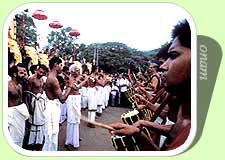
Activities, Events and Recreation
There are a lot of activities that takes place all over the state on Onam. Pulikali performers paint themselves in the guise of a tiger and enact hunting scenes to entertain people. Kummattikali artists don an attire of plaited grass and big wooden mask. They move from house to house collecting small gifts and amusing children.
At Thrissur, caparisoned elephants move out in a procession and present a regal view. While at Cheruthuruthy, Kathakali artists cast a spell on the audience with the magic of their performance. Women perform their graceful traditional clap dance, Kaikotikalli on the day and enthrall the audience. Vallamkali, the popular snake boat race is also organised in several parts of the state to mark the day.
Number of sports and games events are also organised on the day. These are collectively called Onakalikal. Some of them are rigorous sports like Talappanthukali, Kutukutu and combats like Kayyankali and Attakalam. Archery is also a part of Onakalikal. Senior members have their share of fun by playing indoor games like cards and chess. There is also a tradition of swinging on Onam. A decorated swing is swung on a high branch and young men and women take the pleasure on it while singing traditional songs.
Onam is the biggest and the most important festival of Kerala. Festivities of Onam continue for ten long days. Of all these days, most important ones are the first day, Atham and the last or tenth day, Thiru Onam.
Religious and traditional people of Kerala sincerely follow all the customs and traditions set by their ancestors. A number of cultural programmes, dances, songs and feasts mark the festival.
Rituals for the Atham Day
Celebrations commence from the first day, Atham. The day is regarded holy and auspicious by the people of Kerala. People take early bath on the day and offer prayers in the local temple.
Notable feature of this day is that making of Pookkallam or the flower carpet starts from this day. Attha Poo is prepared in the front courtyard by girls of the house to welcome the spirit of King Mahabali in whose honour Onam is celebrated. Boys play a supporting role and help in gathering flowers. In the following days, more flowers are added to Pookalam. As a result Pookalam turns out to be of massive size on the final day.
Preparations for the Thiru Onam starts in a big way and everybody gets engaged to mark the festival in their own style. House cleaning starts on a massive scale and everything is made to look neat and tidy. There is also a set breakfast consisting of steamed bananas and fried pappadam (pappad). This remains the same till the day of Thiru Onam. A swing is also slung on a high branch of a tree. It is decorated with flowers and the youngsters take great delight in swinging and singing, that goes simultaneously.
Rituals for the ninth day-Utradam
A day prior to Onam is the ninth day of the festivities and is known as Utradam. On this day tenants and depends ofTarawads (traditional large joint family sharing a common kitchen and consisting of more than hundred people) give presents to Karanavar, the eldest member of the family. These presents are usually the produce of their farms consisting of vegetables, coconut oil, plantains etc. This gift from the villagers to Karanavar on Onam are called 'Onakazhcha'. A sumptuous treat is offered is offered by Karanavar in return for Onakazhcha. Village artisans also offer a specimen of their handicrafts to the Karanavar of Nayar Tarawads. They receive gracious rewards for this courtesy.
The Big Day - Thiru Onam
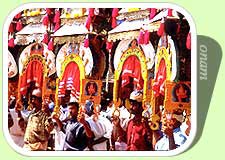
Kerala appears in its grandiose best on this day. Cultural extravaganza, music and feasts add colours of merriment and joy to the God's Own Country. There are celebrations all around the state and everybody takes active participation in them; Onam has assumed a secular character and is celebrated by people of all religions and communities.
Morning Rituals
People wake up as early as 4 am on the day of Onam. Day begins with cleaning of the house. In the earlier days, front courtyards were smeared with cow dungs. The custom is still followed in villages, where the houses are not cemented.
On the day of Thiruvonam conical figures in various forms are prepared from sticky clay and are painted red. These are decorated with a paste made of rice-flour and water and are placed in the front court yard and other important places in the house. Some of these clay figures are in the shape of cone and others represent figures of Gods. Those in the shape of a cone are called, 'Trikkakara Appan'. The tradition of making clay cones for Trikkara Appan has its roots in mythology, which says that festival originated at Trikkakara, a place 10 km from Cochin. Trikkara is also said to be the capital in the reign of legendary King Maveli.
Elaborate prayers ceremonies and poojas are also performed on this day. A senior member of the house plays the role of the priest and conducts the rituals. He wakes up early and prepares ata; Ata is prepared from rice flour and molasses forNivedyam (offerings to God). Lamps are lit up in front of the idols and all members of the house join in for the ceremonies. Priest offers ata, flowers and water in the names of the God. As Onam is also a harvest festival people thank God for the bountiful harvest and pray for the blessings in the coming year. A peculiar custom is followed after this, wherein male members make loud and rhythmic shouts of joys. The tradition is called, 'Aarppu Vilikkukal'. This represents the beginning of Onam.
It is now the time for members of the house to dress up in their best attire and offer prayers in the local temple. Most people wear new clothes on the day. There is also a tradition of distributing new clothes on Onam. In Tharawads (traditional large family consisting of more than hundred people), Karanavar, the eldest member of the family, gives new clothes as gifts, called Onapudava, to all family members and servants. Other members of the family exchange gifts amongst each other.
The Big Feast - Onasadya
After completing the morning rituals, it is time for the family to get ready for the grand meal called Onasadya. The biggest and most prominent place in the house is selected to lay the meal which is traditionally served in a row on a mat laid on the floor.
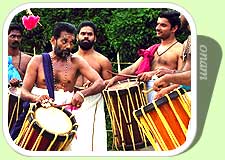
The central place in the row is occupied by the eldest member of the family. In front of him is placed a lighted brass lamp at a distance. Towards the west of the lamp is placed a small plantain leaf on which the food is served. This is an offering made in the name of Lord Ganapathy.
Thereafter, the meal is served to all present. The elaborate meal consists of 11 to 13 strictly vegetarian dishes and is served on banana leaves. There is a fixed order of serving the meal and a set place to serve the various dishes on the leaf. A lot of preparation and hard work goes in making of the scrumptious Onasadya.
Time for Fun - Dances and Games
After the grand meal, it's time for people to indulge in recreational activities and enjoy the festival. Men of strength and vigour go in for rigorous sports while senior and sober members pass time by playing indoor games like chess and cards. There is a set of traditional games to be played on Onam which are collectively called, Onakalikal. It includes ball games, combats, archery and Kutukutu (Kerala version of Kabaddi).
Women go in for dancing activities as there are specific dances like Kaikottikali and Thumbi Thullal for the festival of Onam. Women performing the graceful clap dance called Kaikotti kali in their traditional gold bordered mundu and neriyathu presents a splendid sight. Besides, there is also a tradition of playing on a decorated swing hung from a high branch. Onappaattu - Onam Songs, are also sung on the occasion.
Celebrations and cultural programmes are held all across the state to mark the festival of Onam in which a large number of people participate. Prominent amongst them are Vallamkali- the Snake Boat Race and entertaining events like Kummatti kali and Pulikali. The other highpoint of Onam is the dazzling display of fire works. The state of Kerala can be seen engulfed in light and spirit of merriment when people burst patassu or fire crackers.
Carnival of Onam encompasses a spectrum of fascinating activities. Traditional people of Kerala even go out of their way to celebrate the festival exhaustive of stipulated customs and traditions in full grandiose.
Besides the various rituals that are meant to be completed in individual households, there are a lot of customary activities that are organised at the level of society and city all over the state.
Athachamayam
Athachamyam is a grand procession that marks the beginning of the grand carnival of Onam. It is celebrated with lot of fan-fair on the day of Atham at Thirpunithura and Piravam. The event recalls a royal tradition when Maharajas of erstwhile Kochi State as a custom traveled to the Thripunithura Fort with their entire entourage. Today, even in the absence of the King, the custom retains its regal charm. Highpoints of the event are performances by folk artistes, caparisoned elephants, musical ensembles and dance shows by skilled artsites.
The most enthralling and popular of all such customary events is the Vallamkali or the Snake Boat Race. The event is held just a few days before Thiru Onam. Though the event takes place at several places in the city, the most important of them all is the one organised at Alappuzha. A large number of big and decorated boats called chundan vallams participate with hundreds of boatmen. Rowing of boats on the rhythm provided by the songs and music of the drum makes it a captivating event.
Aranmula Uthrittathi
This is another magnificent boat event organised in connection with Onam. This annual event takes place on the day of Uthrittathi Asterism at Aranmula. This is meant to relive mythology that narrates a story of Lord Krishna crossing the river on that particular day. It is believed that the spirit of the Lord is present on all the boats hence there is no competition of any sort in this event. A large number of people come to watch the joyous event. Some also offer Valla Sady as a vazhipadu (offering) in the temples on this occasion.
Trichur, the cultural capital of Kerala, marks the festival in its own beautiful style. Here, a procession of decorated elephants in carried out on the streets. It's a resplendent site to watch the bejeweled elephants walking on the streets in their full majesty and grandeur. Children particularly take great delight in watching the show of their favourite animal. Songs, dance and merry making are a part of this event.
Celebrations at Cheruthuruthy
Renowned for housing the famous, Kerala Kalamandalm, the Kathakali Training Centre, Cheruthuruthy is a small village in the north of Trissur district. Onam celebrations at Cheruthuruthy are marked for the Kathakali performance by the best artists of the state. A large number of people gather in this village to watch the enactment of scenes from epics and folk tales.
This is the most entertaining custom of Onam. In this performers take the guise of tigers. They paint their bodies yellow with patterns of black and red. Scenes of tiger hunting goats and tigers being hunted by humans are beautifully depicted through this folk art. Beat for the performance is provided by udukku and thakil. Pulikali performance of Thrissur and Palghat districts are the most famous.
This is another recreational folk dance from the state of Kerala, particularly South Malabar. Clad in plaited grass and a huge colourful wooden mask, Kummattikali performers can be seen entertaining people on the festive occasion of Onam. Children are a huge fan of the performance. Mythological and folk themes are enacted on the beat of onavillu in Kummattikali.
An integral tradition of Onam, Pookalam has come up as an art form. Competitions for decorating Pookalams are organised all over the state. They are extremely popular and witness the participation of large number of Pookalam designers and onlookers. Creativity of the designers in unleashed through such competitions as they come up with innovative designs each year.
Kaikottikali is an elegant clap dance performed on the occasion of Onam. In this women sing songs praising the legendary King Mahabali and dance around the pookalam. At the centre of this is placed a lit bronze lamp called nilavilakku. It is a captivating sight to watch troupe of female dancers performing in their traditional Kerala attire consisting of gold bordered off-white mundu-neriyathu and decked with a fragrant gajra in their hair.
Women also perform Thumbi Thullal as a custom in Onam. It is a folk dance performed by a group of women who sit in the formation of circle. The lead performer sits inside the circle who initiates the song which is taken up by other singers. Clap dance is also performed by the women dressed in their best clothes and ethnic jewelery.
This is a collective name for all the games played on the occasion of Onam. Traditional games of Onam constitute rigorous sports like Talappanthukali, Kutukutu and combats like Kayyankali and Attakalam. Archery is also a part of Onakalikal. Senior members go in for indoor games like cards and chess. Sports events are organised by variouOnasadhya is the most delicious part of the grand festival called Onam. It is considered to be the most elaborate and grand meal prepared by any civilisation or cultures in the world. It's a feast which if enjoyed once is relished for years.
Onasadhya is prepared on the last day of Onam, called Thiruonam. People of Kerala wish to depict that they are happy and prosperous to their dear King Mahabali whose spirit is said to visit Kerala at the time of Onam.
Legend goes that Mahabali who was so attached to his people that he requested Gods to allow him to visit Kerala every year. People of Kerala wish to convey that they are enjoying the same age of prosperity as was witnessed during the reign of King Mahabali by preparing a grand Onasadhya.
Rich and the poor, everybody prepares Onasadya in a grand fashion as people of Kerala are extremely devotional and passionate when it comes to Onasadya. So much so that, it has lead to saying, 'Kaanam Vittum Onam Unnanam'. Meaning - men go to the extend of selling all their possessions for one Onam Sathya.
The Meals
Rice is the essential ingredient of this Nine Course Strictly Vegetarian Meals. All together there are 11 essential dishes which have to prepared for Onasadya. Number of dishes may at times also go upto 13. Onasadya is so elaborate a meal that it is called meals, even though it is consumed in one sitting. Onasadya is consumed with hands, there is no concept of spoon or forks here.
Traditional Onam Sadya meal comprises of different varieties of curries, upperies - thigs fried in oil, pappadams which are round crisp flour paste cakes of peculiar make, uppilittathu - pickles of various kinds, chammanthi - the chutney, payasams and prathamans or puddings of various descriptions. Fruits and digestives are also part of the meal.
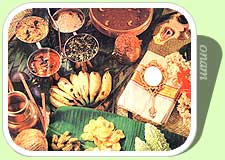
The food has to be served on a tender Banana leaf, laid with the end to the left. The meal is traditionally served on a mat laid on the floor. A strict order of serving the dishes one after the another is obeyed. Besides, there are clear directions as to what will be served in which part of the banana leaf.
These days Onadaya has toned down a little due to the urban and hectic living style. Earlier, Onasaya used to be even more elaborate. There were about 64 mandatory dishes - eight varieties each of the eight dishes. At that time three banana leaves were served one under the other to accommodate all the dishes. How exactly they were accommodated in the tummy..is a food for thought!
How is it Served
There is a distinct order of serving the the grand feast of Onam. Pappad or Pappadum is to be served on the extreme left. On top of the big pappadum banana is served. The banana can be 'Rasakadali', 'Poovan', 'Palayankodan'. From the right pappad - salt, banana wafers, sarkarapuratti fries are served. After this, ginger lime and mango pickles are served. Next comes 'vellarika', 'pavakka', beetroot and 'ullikitchadi'. 'Kitchadi' made of pineapple and banana splits or of grapes and apple is served along with this. On the right, 'cabbage thoran' is served. Then comes a thoran made of beans and avil followed by bread and green peas mix 'thoran'. The meal will be complete with the 'avial' and 'kootu curry'.
Rice is served when the guests seat themselves and just two big spoons is considered enough. After this 'parippu' and ghee is poured. Then comes Sambhar. Desserts are to begin with adaprathaman followed by 'Kadala Payasam'. This colourful arrangement on the lush green banana leaf makes the food look even more tempting and irresistible .
Hold on...Be a little patient....you need to wait a little before you start gorging the lip smacking meal. There are some rituals which need to be followed. First full course meal is served for Lord Ganapathi in front of a lighted oil lamp (Nila Vilakku). This is in accordance with the Malayalese trend of starting everything in the name and presence of God.
More About the Meal
For a better understanding of the Onasadhya meal let us now go through all the dishes in a little more detail. If that temps you too much, take a look at the recipes section and enjoy your Onam whenever you want.
Erissery
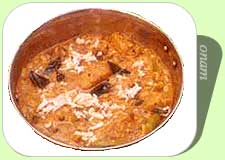
This is either prepared from pumpkins/red beans or from yam and raw bananas cubes. The spices used in this include split green chillies, ground coconut, cumin seeds, turmeric and red chillies. Erissery is seasoned with mustard seeds spluttered in oil. This is a main stay for the occasion, though not very popular these days.
Kalan or Pulisseri
This is prepared from buttermilk. Ingredients consist of sliced plantains called nenthra-kaya and yams or chena. These are boiled in water with salt and chillies. It is flavoured with ground coconut and mustard seeds spluttered in oil. Some even add cucumber cubes to Kalan.
Olan
Olan is prepared from sliced cucumber and brinjal. Sometimes pulse is also added. They are boiled in water with salt and no chillies. When properly boiled, some fresh coconut oil is poured. The dish is seasoned with flavour kariveppila (curry leaves).
Aviyal
This is kind of a mixed vegetable as all sorts of available vegetables are added to it. All vegetables are first boiled in water with salt and chillies. Tamarind and well ground pulp are added at proper time. Aviyal is flavoured with coconut oil and Kariveppila.
Thoran
Thoran is prepared by slicing beetroot and several other vegetables into very small pieces. These are then boiled in water with some salt and chillies till all the water dries up. Water can also be strained away. For seasoning, ground coconut pulp and mustard fried in coconut oil is used.
Mulakoshyam
This resembles olan. It is a special Onam delicacy from the state of Kerala and has been recently added to Onam Sadhya.
Koottukari
This is a curry consisting of a variety of vegetables and some Bengal gram. It differs from Aviyal as it does not contain tamarind.
Sambar
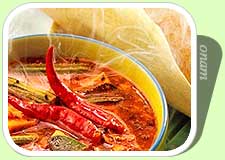
This is an extremely popular recipe from South India and relished by the whole of India. It consists of dal and a variety of vegetables like brinjal, drum-sticks, pavakkai (bitter gourd), etc. All vegetables are first boiled in water with salt and chilies. Tamarind is also added to enhance the taste. Other spices like coriander, cumin seed etc. are fried in oil and powdered. Sambhar is flavoured with mustard seeds and asafoetida.
Pachchati, Kichchati
These are types of curry consisting chiefly of cucumber, mustard and sour butter milk or curds. In Kichchatim, young and tender cucumber is added
Rasam
This lip smacking recipe is prepared from tomatoes treated with tamarind juice. It is seasoned with bay leaves and mustard seeds spluttered in oil. Some people take rasam with rice. Rasam also helps in digestion.
Payasam
This is an extremely delicious dish and is a sort of pudding. It is prepared from boiled potatoes mixed with molasses and coconut milk. The mixture is flavoured with spices. There is another type of payasam called 'Pal Payasam' in which rice is boiled with milk and sweetened with sugar.
Prathaman
There is a whole variety of Prathamans such as ata, pazham, parippu and palata prathamans.
Beverages
A special drink is prepared for Onam in which water is boiled with a combination of cumin and dried ginger (chukku). This is beneficial from health point of view.

Upperi or Chips
Upperi is prepared from various things like raw bananas (kaaya), yam (chena), jack fruit (chakka), bitter gourd (pavayka) and egg plant fruit (vazhuthanga). Slices of the ingredient are fried in coconut oil to a crisp condition.
Pickles (Achaar)
These are prepared well in advance of Onasadhya. Pickles are chiefly made from mango, lemon, ginger, chillies and curry naranga.
Pappads (Pappadam)
These are prepared from black grams and are fried in oil. Pappadams are usually served in three sizes - small, medium and large.
Fruits
Chiefly plantain fruits of various kinds are served along with other articles of food at meals.s social and cultural organisations all over the state.
Pookalam is an intricate and colourful arrangement of flowers laid on the floor. Tradition of decorating Pookalam is extremely popular in Kerala and is followed as a ritual in every household during ten-day-long Onam celebrations.
'Pookhalam' consists of two words, 'poov' meaning flower and 'kalam' means colour sketches on the ground. It is considered auspicious to prepare Pookalam, also known as 'Aththa-Poo' during the festival of Onam.
People believe the spirit of their dear King Mahabali visits Kerala at the time of Onam. Besides making several other arrangements, people, especially adolescent girls prepare elaborate Pookalams to welcome their most loved King.
Making of a Pookalam
Kilo and kilos of flowers, lot of dedication, creativity, technique and team effort are the basic essential of an eye catching Pookkalam.
Athapoovu are usually circular in shape and multi-tiered colourful arrangements of flowers, petals and leaves. Use of powder colours, desiccated coconut or artificial flowers is prohibited. Pookalams are normally laid on the front court yard of the house. Idols of Mahabali and Vishnu are placed in the center of the Pookalam and worshiped. Diameter of a Pookalam normally ranges from four to five meters.
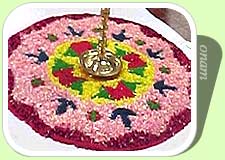
Ritual of making the flower mats continues for all ten days of Onam. Designing starts from the day of Atham and is made ready by Thiruvonam day. Basic design is prepared on the first day. Size of a Pookalam is increased by adding more to it on every passing day hence a massive Pookalam gets ready for the main day of the occasion. Its a big creative task, as designers have to think of a new design ever day.
Various flowers are used on each day as a specific flower is dedicated to each day of Onam. Commonly used flowers include Thumba (Lucas Aspera), Kakka Poovu, Thechipoovu, Mukkutti (little tree plant), Chemparathy (shoe flower), Aripoo or Konginipoo (Lantana), Hanuman Kireedom (Red pagoda plant) and Chethi (Ixora). Of all these flowers, Thumba flowers are given more importance in Pookalam as they are small in size and glitter in the the soft rays of the sun. 'Thumba Poo' is also considered to be the favourite flower of Lord Shiva and King Mahabali was a devout worshipper of Shiva.
On the next day of Onam, Thumba flowers are used to decorate Onapookalam. The arrangement is not touched for the next 15 days. On the 15 th day, called 'Ayilyam', Pookalam is decorated again. On the next day, called Magam, Pookalam is given a cut in its four corners with a knife. This marks the end of Pookalam decorations for the year. Some also follow the tradition of erecting a small pandal over the completed flower carpet and decorating it with colourful festoons.
Making of Pookalam is itself a colourful and joyous event. Being a team effort it helps to generate feeling of togetherness and goodwill amongst the people. It is animating to watch women as they prepare Pookalam while singing traditional songs. Giggling and sharing jokes between the thought provoking and back breaking job.

Trends
Earlier, people used to make efforts to collect flowers for designing a Pookalam. Children used to get up early in the morning and gather flowers in their small 'Pookuda' (basket) from the village gardens. These days, the trend has changed and people have the option of buying flowers from the market in the shape and colour of their choice.
Pookalam decoration competitions are organised by various societies and groups all over the state on the day of Onam. They have become extremely popular and witness huge public participations. Big prizes are also kept in these contests as they have turned up to be extremely competitive events. A large number of people assemble just to have a look at the innovative and meticulously prepared art pieces.
A beautiful design, though it is said, is created in the heart, use of technology is also in vogue in designing of a Pookalam. People prepare design first on computer and then implement it on floor. This saves a lot of time and energy and helps the designers to come up with stunning Pookalams.